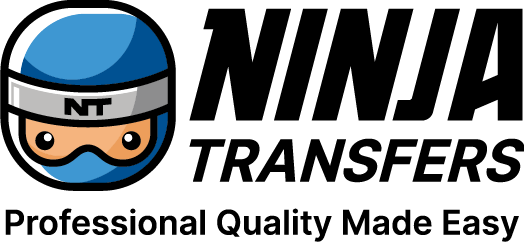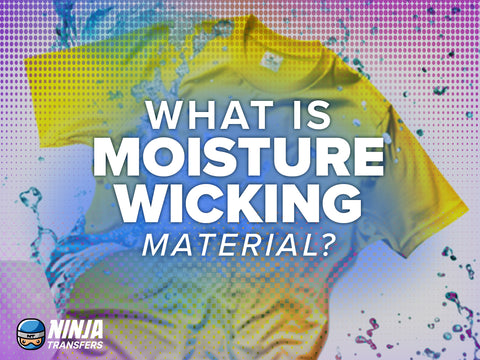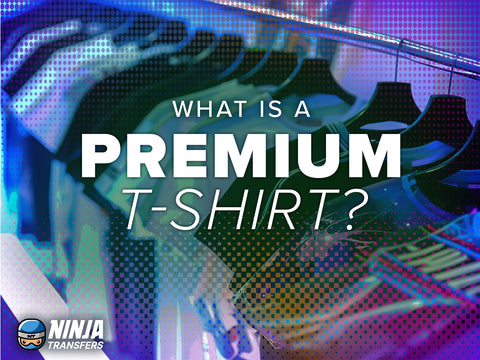The activewear industry is expected to generate more than 85 billion U.S. dollars by 2028 in the United States alone. Performance fabrics are more popular than ever. You've probably seen the term "moisture-wicking" in product descriptions and might be wondering what it means.
By moisture, they mean sweat–and nobody wants that. People don't even like the word moist.
But what is wicking exactly? We're here to give you an up-close and personal look at moisture-wicking material. We break down how it works, why it's so popular, and if it's right for you. Read on to learn more.
Table of contents
- What Is Moisture-Wicking?
- How Does It Work?
- Which Fabrics Are Moisture-Wicking?
- Printing on Moisture-Wicking Material
- Why Choose Moisture-Wicking Material?
- Conclusion
01:[image: Collage of models wearing various performance wear: t-shirts, long sleeve, tank top, athletic jersey, etc]
What is moisture-wicking?
Moisture-wicking material is a type of fabric designed to pull moisture away from the skin and quickly evaporate it, keeping the wearer dry and comfortable. In the custom apparel world, moisture-wicking fabrics are often used to create activewear, performance wear, and athletic uniforms. These materials are engineered to efficiently move sweat from the skin to the fabric's outer surface, where it can evaporate more easily.
Along with keeping you dry, moisture-wicking fabrics also help regulate your body temperature. As the moisture evaporates from the surface of the fabric, it creates a cooling effect, similar to how your skin feels cooler when wet. This temperature regulation can be a godsend–especially when performing physical activities on a hot day–preventing overheating and keeping you comfortable.
Moisture-wicking fabrics are often referred to as performance fabrics, an all-inclusive marketing term. When you see this phrase used, it typically means that moisture-wicking is one of the fabric's key features. However, performance fabrics may also include other properties like stain, wrinkle, and snag resistance.
Enterprising brands will claim to have superior high-tech functionality through unique weave designs and proprietary treatments. They often trademark their technologies with names like "Dri-FIT," "Cool Dry," or "Dry Power." While some high-tech fabrics perform better, it's important to remember that most synthetic fabrics are inherently moisture-wicking simply because they don't absorb moisture like natural fibers do.
02:[image: infographic showing the moisture-wicking process.]
How does it work?
Moisture-wicking fabric works through a two-step process. The first is wicking: The fabric pulls sweat away from your skin and moves it to the outer surface. The second is evaporation: Once the sweat reaches the outer surface, it dries rapidly. But how exactly does it achieve this? Let's break it down into the key elements that make the moisture-wicking fabric so effective.
Capillary action
The driving force behind moisture-wicking is a phenomenon called "capillary action." This refers to the movement of a liquid through narrow spaces, such as the tiny gaps between the fibers of a fabric, without the assistance of external forces like gravity. Capillary action occurs due to the interplay of adhesive forces (attraction between the liquid molecules and the fiber surface) and cohesive forces (attraction between the liquid molecules themselves).
When you sweat, the moisture is drawn to the fabric fibers through adhesive forces. As more sweat accumulates, cohesive forces pull the moisture along the fabric fibers, effectively wicking it away from your skin and toward the fabric's outer surface. The strength of the capillary action depends on factors such as the size of the spaces between the fibers, the surface tension of the liquid, and the chemical interaction between the liquid and the fiber surface. Moisture-wicking fabrics are engineered to optimize these factors, ensuring efficient moisture transport.
Fabric materials
Moisture-wicking fabrics are typically made from synthetic fibers, such as polyester, nylon, or polypropylene. These fibers are naturally hydrophobic, meaning they have a low affinity for water. This water-repellent property is crucial for moisture-wicking performance, as it prevents the fibers from absorbing sweat and allows the moisture to be transported along the fabric's surface.
The hydrophobic nature of synthetic fibers is due to their chemical structure. These fibers are made from long chains of polymers that lack the polar groups found in natural fibers like cotton. The absence of these polar groups results in low surface energy, which causes water molecules to be repelled rather than attracted to the fiber surface.
In contrast, natural fibers like cotton are hydrophilic, meaning they have a high affinity for water. When cotton fibers come into contact with sweat, they absorb the moisture, causing the fabric to feel damp and heavy. This absorption also hinders evaporation, as the sweat is trapped within the fibers rather than transported to the fabric's outer surface.
Yarn design
The design of the yarns used in moisture-wicking fabrics plays a significant role in enhancing the fabric's performance. Some manufacturers employ specially engineered yarns, such as Coolmax or cross-shaped yarns, which are designed to optimize the wicking process. These yarns feature unique cross-sectional shapes that differ from the traditional circular shape of regular yarns.
The distinctive shapes of these specialized yarns create channels and grooves within the fabric structure. These channels act as miniature pathways that guide sweat away from the skin and towards the fabric's outer surface. By providing a more efficient route for moisture transportation, these specially designed yarns enhance the overall wicking performance of the fabric.
Fabric construction
In some high-performance moisture-wicking garments, you'll find a two-layer construction. The inner layer, which sits next to your skin, is made from a hydrophobic material that repels sweat. The outer layer is made from a hydrophilic (water-loving) material that attracts moisture. This creates a push-pull effect, effectively moving sweat away from your skin and toward the outer surface for rapid evaporation.
Finishing treatments
To enhance the moisture-wicking properties of a fabric, manufacturers may apply special finishes or treatments. These can include microfiber constructions that increase the fabric's surface area, allowing for more efficient moisture transfer, or hydrophobic coatings that further repel water and prevent absorption.
By combining these elements–the two-step process, capillary action, hydrophobic materials, specialized yarn designs, strategic fabric construction, and finishing treatments–moisture-wicking fabrics create a high-performance system that keeps you dry, comfortable, and focused on your activities.
03:[image: infographic showing the difference between fibers, yarn, and fabric.]
Pro-tip: Moisture-wicking is more effective when the garment is closest to the skin. While the thought of tightly fitting polyester on a hot day doesn't sound particularly appealing, that's what works best. This is because the closer the fabric is to the skin, the more efficiently it can wick away sweat. Loose-fitting clothing may feel more comfortable initially, but it can actually hinder the moisture-wicking process by allowing sweat to remain on the skin longer.
Which fabrics are moisture-wicking?
While many types of t-shirt fabric can claim moisture-wicking properties, not all materials are equally effective. Here's a brief look at the top moisture-wicking fabrics and how well they work.
Synthetics
In today's market, synthetic fabrics like polyester, viscose/nylon, and spandex make up the majority of moisture-wicking performance fabrics. 100% polyester is the primary choice for many brands, but garments that incorporate viscose or spandex offer added stretch, allowing for more form-fitting designs. As mentioned earlier, form-fitting garments can enhance the effectiveness of moisture-wicking properties.
Blends
Blended fabrics, such as 50/50 cotton/polyester, CVC (Chief Value Cotton), and tri-blends, have varying degrees of moisture-wicking properties based on the relative percentage of cotton in the mix. For example, a tri-blend fabric, which typically contains a combination of polyester, cotton, and rayon, will wick more moisture than a 90/10 CVC fabric with a higher cotton content.
Naturals
Wool is the original moisture-wicking fabric and has been used throughout history for its natural performance properties. People have relied on wool from ancient civilizations to modern-day outdoor enthusiasts to keep them dry and comfortable in various conditions. However, most people don't typically think of wool as a performance fabric despite its excellent moisture-wicking capabilities.
Bamboo is another natural fabric option that offers moisture-wicking properties. However, it may not perform as well as synthetic fabrics and can be more expensive. Bamboo is often touted as an eco-friendly alternative to synthetic fabrics, but it's important to note that the process of turning bamboo into fabric can be resource-intensive and may involve harsh chemicals.
Weaves and knits
Certain weaves and knits, like pique and mesh, can also contribute to moisture-wicking properties. The texture and design of these fabrics help facilitate the movement of moisture away from the skin. Pique and mesh are commonly found in golf shirts and corporate wear.
04:[image: close-up photos of various moisture-wicking fabrics]
Is cotton moisture-wicking?
Not at all. In fact, cotton is the opposite of moisture-wicking–it's absorbent. When you wear cotton, it traps sweat and absorbs it, preventing the moisture from evaporating. This leads to a clammy, damp feeling that can linger long after you finish your workout or step out of the heat.
What about "high-performance" cotton?
This is usually just regular cotton that has been treated. Or it's blended with synthetic fibers. While marketed as a moisture-wicking solution, these fabrics don't have the same natural moisture-wicking properties as purely synthetic materials. High-performance cotton might be a good choice if you need your shirts to be hypoallergenic, as people with sensitive skin may find synthetic fabrics irritating.
It's important to remember that marketing claims can be misleading, and just because a cotton garment is labeled as "high-performance" doesn't mean it will keep you as dry and comfortable as a synthetic moisture-wicking fabric would.
Printing on moisture-wicking material
When creating custom moisture-wicking apparel, it's important to understand how different print methods perform on synthetic materials. Choosing the right printing technique can make a significant difference in the quality, durability, and overall effectiveness of the moisture-wicking properties of your garments.
-
Sublimation printing is popular for 100% polyester moisture-wicking fabrics, particularly in light colors. This method produces permanent and vibrant colors with photo-quality details and gradients. Sublimation allows for an "all-over print" look, meaning the design can cover the entire garment seamlessly. One downside is that sublimation does not work well with dark-colored fabrics, as no white ink is used in the process. Sublimation printing does not significantly interfere with the moisture-wicking properties of the fabric, but it can be more expensive than other methods.
-
DTF (Direct-to-Film) transfers work well on any color and type of fabric, including moisture-wicking materials. This method produces vibrant colors and photo-quality details, making it a versatile choice for custom apparel. DTF transfers are easier to print and more cost-effective than sublimation. They can also stretch when printed on viscose/nylon/spandex blends, making them suitable for form-fitting athletic wear. However, large DTF designs may block the moisture-wicking properties of the fabric, so it's best to keep designs small or incorporate open, breathable elements to maintain the fabric's performance.
-
Screen printing is possible on moisture-wicking materials, but it is not recommended due to potential issues with print quality and dye migration. Dye migration occurs when the ink used in screen printing interacts with the dyes in the polyester fabric, causing the colors to bleed or change over time, particularly when exposed to heat. This can result in a less-than-ideal appearance and may compromise the integrity of the design.
-
DTG (Direct-to-Garment) printing is not suitable for polyester or other moisture-wicking materials. The ink used in DTG printing does not adhere well to the synthetic fibers, leading to poor print quality and durability. This compatibility issue rules out offering polyester items for sale at most print-on-demand (POD) or drop shipping operations, as the vast majority of these services rely solely on DTG printing. As a result, they typically only offer cotton garments.
05:[image: models wearing custom-printed performance garments]
Why choose moisture wicking material?
We don't typically recommend performance wear for the average everyday t-shirt order since most people naturally prefer cotton or blends. However, if you have a particular use case that can benefit from moisture-wicking ability, that's when it's time to consider performance material. Here are some popular categories and use cases where moisture-wicking fabrics shine:
Athletic gear
Moisture-wicking fabrics are a top choice for athletic clothing, as they help keep the wearer dry and comfortable during intense physical activity. The temperature-regulating properties of these fabrics can also help prevent overheating, while their smooth surface reduces friction and chafing. Common athletic gear items that benefit from moisture-wicking properties include:
- Gym attire: T-shirts, tank tops, shorts, and leggings for weightlifting, cardio, and fitness classes
- Team uniforms: Jerseys, shorts, and socks for basketball, soccer, volleyball, and other sports
- Running apparel: Shirts, shorts, and jackets for jogging, marathons, and 5K races
Activewear and athleisure
Moisture-wicking fabrics are also popular in activewear and athleisure clothing, which are designed for both physical activity and everyday wear. These garments often prioritize comfort, flexibility, and style, making moisture-wicking properties a valuable addition. Examples include:
- Yoga pants and tops for studio sessions and casual wear
- Leggings and sports bras for dance classes and leisure
- Jackets and hoodies for outdoor activities and lounging
Outdoor and adventure wear
When it comes to outdoor events and adventures, moisture-wicking fabrics can provide both comfort and protection. They are an excellent choice for clothing worn during summer outdoor events, hiking trips, and other activities where staying dry and cool is essential. Some examples include:
- Hiking shirts and pants for trails and camping
- Fishing shirts and shorts for long days on the water
- Performance t-shirts for summer festivals and outdoor concerts
Corporate and promotional wear
Moisture-wicking fabrics can also be suitable for corporate and promotional wear, especially for events that involve physical activity or outdoor settings. Some use cases include:
- Golf shirts for company tournaments and outings
- Polo shirts for trade shows and conferences
- Performance t-shirts for company picnics and team-building events
Workwear
In certain professions, moisture-wicking fabrics can provide both comfort and functionality. They are often used in workwear for jobs that involve physical labor or exposure to hot environments, such as:
- Construction workers' shirts and pants
- Landscapers' and gardeners' attire
- Chefs' and kitchen staff's uniforms
Pro tip: When considering moisture-wicking fabrics, keep in mind the preferences of your audience. While these fabrics offer plenty of benefits, some individuals may find them less comfortable due to skin sensitivities or may be particular about how a t-shirt fits. In those cases, you should include some cotton blend items as alternative a fabric option so everyone's needs are met.
06:[image: collage of the variety of performance wear (golf shirts, corporate, athleisure, work wear) might be good to have them custom branded, like a left chest, etc]
Making moisture-wicking fabrics work for you
By now, you should have a solid understanding of what moisture-wicking fabric is, how it works, and whether performance fabrics are the right choice for your needs. Whether you're creating custom athletic wear, designing uniforms for a sports team, or looking for the perfect promotional t-shirts for an outdoor event, moisture-wicking materials can provide the comfort, performance, and durability you need.
At Ninja Blanks, we offer a wide selection of moisture-wicking blank apparel to suit your every need. From 100% polyester to blended fabrics, our collection includes a variety of styles, colors, and sizes to help you bring your creative vision to life.
When it comes to printing, trust Ninja Transfers for all your DTF transfer needs. Our expert team is dedicated to providing you with the highest-quality transfers and exceptional customer service, ensuring that your custom apparel looks great and performs even better.




评论 (0)
这篇文章没有评论。成为第一个在此留言的人!